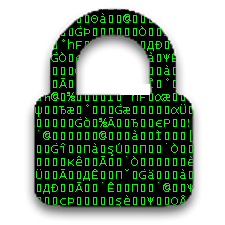Difference between revisions of "Encryption"
(split into sections) |
Joe90862nj (talk | contribs) (work in progress.) |
||
| Line 4: | Line 4: | ||
|constitutes=technology | |constitutes=technology | ||
}} | }} | ||
| − | '''Encryption'' is the process of changing data from an understandable form into a scrambled form. The inverse process, of restoring the original data from the encrypted forms referred to as [[decryption]] (or deciphering) | + | '''Encryption'' is the process of changing data from an understandable form into a scrambled form. The inverse process, of restoring the original data from the encrypted forms referred to as [[decryption]] (or deciphering). |
| − | + | ==Background== | |
| − | == | ||
The {{ccm}} fairly regularly have stories suggesting that a battle is ongoing between [[intelligence agencies]] and companies around encryption. This may well be mere [[smoke and mirrors]] to obscure the reality that a large proportion of all large companies' encryption products are cracked, whether by design or by faulty programming. | The {{ccm}} fairly regularly have stories suggesting that a battle is ongoing between [[intelligence agencies]] and companies around encryption. This may well be mere [[smoke and mirrors]] to obscure the reality that a large proportion of all large companies' encryption products are cracked, whether by design or by faulty programming. | ||
Revision as of 15:09, 8 August 2016
(technology) | |
|---|---|
 | |
| Interest of | • Laura Halminen • Bruce Schneier |
'Encryption is the process of changing data from an understandable form into a scrambled form. The inverse process, of restoring the original data from the encrypted forms referred to as decryption (or deciphering).
Contents
Background
The commercially-controlled media fairly regularly have stories suggesting that a battle is ongoing between intelligence agencies and companies around encryption. This may well be mere smoke and mirrors to obscure the reality that a large proportion of all large companies' encryption products are cracked, whether by design or by faulty programming.
Keys
Rubber hose method (i.e. torture) ...
Legal status
The deep state appears to be trying to use the "war on terror" as an excuse to outlaw encryption. This agenda is regularly promoted stepwise after "terrorist" attacks. It is proceeding at different rates in different countries.
Australia
Under the 2015 Defence Trade Controls Act, which came into force in 2016, it may be illegal to learn about encryption in Australia.[1]
USA
In April 2016, a draft of a law called the Compliance with Court Orders Act were leaked, which suggested broad plans to make encryption illegal. The Business Software Alliance came out against the Burr-Feinstein bill, saying it "strongly urges" the US Congress to think again.[2]
Future
The good professionals know, that encryption must be in the hands of end-users; including "operators" and "actors" in the intelligence definition.[citation needed] Many people (including Joe Tag) believe that no sovereign government, police agency, criminal or terrorist group needs to know their plans immediately; and that when proper encryption is employed, clear data may be discovered only after 2 weeks to 10 years of continuous cryptanalytic processing. Some[Who?] suggest key sizes of 48 characters ( 384 bits) to 64 characters ( 512 bits) for a single message.
Language
CODING has several meanings: 1) To program, "to code"; 2) To convert and change data from one form into another.
See also codebook . regarding CODE BOOKs.
e.g.: To convert letters to numbers (a=00, b=01, z=25; or this scheme of a=11, b=12, c=13, z=36, 0=00, 1=01, 9=09 ) ; or analog speech into
a digital stream or digital buffer ie: "Code Excited Linear Predictive coding, CELP" .
Encryption has 3 to 5 parts: "M" a MESSAGE; "K" a Key to encrypt a message, and "C" the result resulting encrypted data.
Part 4 and part 5 may be 2 additional keys that interact with other keys.
Digital Encryption dates to 1919 at AT&T Federal Labs in the financial district of New York City. A pioneer in this work was
Gilbert Vernam.
An example
| Page name | Description |
|---|---|
| TrueCrypt | Widely praised disk encryption software, abruptly discontinued in 2015. Version 7.1a (not 7.2) is the latest fully functional version. |
Related Quotations
| Page | Quote | Author | Date |
|---|---|---|---|
| Roger Dingledine | “The United States government can’t simply run an anonymity system for everybody and then use it themselves only. Because then every time a connection came from it people would say, “Oh, it’s another CIA agent.” If those are the only people using the network.”” | Roger Dingledine | 2004 |
| Rod Rosenstein | “Responsible encryption is achievable. Responsible encryption can involve effective, secure encryption that allows access only with judicial authorization. Such encryption already exists.” | Rod Rosenstein | 10 October 2017 |
| Malcolm Turnbull | “The laws of Australia prevail in Australia, I can assure you of that. The laws of mathematics are very commendable but the only law that applies in Australia is the law of Australia.” | Malcolm Turnbull | 14 July 2017 |
| Christopher Wray | <nowiki>“To put it mildly, this [[[encryption]]] is a huge, huge problem. It impacts investigations across the board — narcotics, human trafficking, counterterrorism, counterintelligence, gangs, organized crime, child exploitation.”</nowiki> | Christopher Wray | 2017 |
An official example
| Name |
|---|
| Signal Messenger |